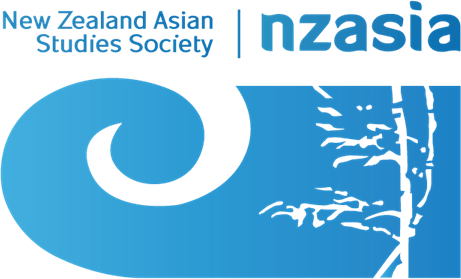Promoting Cantonese-New Zealand Heritage: A Profile of Kirsten Wong and Nigel Murphy (Part 2)27/2/2021 By James Beattie, Victoria University of Wellington
Can you let me know about two current projects you are working on, and why you think they are important? Kirsten: This week I've been working on the Ventnor memorial project for the New Zealand Chinese Association (NZCA). On 9 December 2020, our Ventnor memorial was officially blessed alongside the newly opened Manea Footprints of Kupe Cultural Centre in Opononi. The memorial is for the 499 former Chinese miners whose remains were lost when the SS Ventnor sunk off the Hokianga coast in 1902. The NZCA memorial features the names of all 499 people whose remains were lost, plus the 13 passengers and crew who lost their lives in the sinking. The Ventnor story is really one of our community's most significant historical moments because it is literally a living piece of history. After the boat sank, remains began washing ashore and were picked up and cared for by those who lived along the coastlines, including people from Te Roroa and Te Rarawa who live to the south and north of the Hokianga Heads. They have been caring for the history and the remains since 1902. The Chinese community of descendants was only made aware of this in 2007. Since then we have formed close relationships with Te Roroa and Te Rarawa, Te Mahurehure and now Te Hua o te Kawariki Trust which is behind the Manea centre. This memorial was always about honouring our ancestors, but it was also to pay homage to the kind people of the Hokianga who have been caring for our ancestors' remains for all this time. We feel it's a history that should be remembered and celebrated, especially because of the values that make this story so special: the importance of ancestral heritage, the links to the land, the relationships within and between families and communities, and the importance of kindness. The memorial, we hope, will be just the beginning of an ongoing story. And to do a complete turnaround, the other thing I've been working on in the past few days has been NZCA's response to the New Zealand Qualifications Authority after writings by a white supremacist, Lionel Terry, were included in an NCEA Level 2 history exam. Terry murdered an elderly man, Joe Kum Yung, on Wellington's Haining St in 1905 to bring attention to his anti-Chinese views. The wonderful writer Chris Tse wrote an excellent Spinoff article about this: Rhymes of the ancient murderer: How a racist killer became an NCEA question There's also an incredibly powerful poem written by the young woman, Cadence Chung, who along with her friend Julia Randerson, first brought the issue to public attention. The poem is published on Poetry Shelf and is titled Shadows/Shades. Both are incredibly rewarding pieces of writing. Nigel: The major project at the moment is an update of the Poll Tax Report commissioned by the NZCA in 1992 as part of its campaign to obtain an official apology from the government for the poll tax (which was achieved in 2000) The update is very much expanded and includes a lot more background on the people who paid the tax, where they came from, how they got here, what sort of people they were, and what their life was like here. I’ve also discovered some facts that rather upturn the current narrative on the poll tax story from the New Zealand government side. I’m also involved in a project co-ordinated by Sydney Shep and Ya-Wen Ho 賀雅雯 from the Wai-te-ata Press at Victoria University to translate and publish – with contextual narrative – a series of poems written by the editor of the Dominion Federation of Chinese Commercial Growers Monthly Journal, and published in that journal in the late 1960s. They’re a fascinating insight into Chinese New Zealand life at the time, and I’m sure it will be a major contribution to Chinese New Zealand studies. I’m also contributing a chapter for an upcoming book on the extreme Right in New Zealand. The chapter will look at the ongoing influences of the 20th-century White New Zealand policies on Far Right attitudes and thinking in New Zealand in the 2020s. What do you think would be a good way to help connect community-led, independent researchers and university academics? Kirsten: We should all be seeking common ground I think. I love it when university academics actively include communities. It's an old saying but it still holds true - never about us without us. I'm a big fan of the work of Dr Sydney Shep and Ya-Wen Ho of Victoria University's Wai-te-Ata Press. They've been fantastic in building and nurturing community relationships, as well as bringing members of the faculty together with community members. We need more spaces like that. Nigel: There are a couple of factors that make doing this quite difficult. The main one is that academic and community historians are coming from different places and are generally heading in different directions. The difference lies in the purposes of the two forms of history, their aims, their approaches, and their desired outcomes. Both forms fulfil quite separate needs. One fulfils deeply personal needs and addresses both personal and community identities. The other is objective, dispassionate, forensic, and universal. Histories of Chinese people in New Zealand written by community historians tend to consist of lists of people and heroic tales of pioneers in a "let us now praise great men" form. In these histories the pioneers are all brave, good, compassionate, and resourceful. They overcome great obstacles to found the successful, happy families of today. As far as Chinese New Zealand history is concerned at the moment the focus is on lists of names and family stories, and this is what the community is wanting. The academic approach is quite the opposite. It analyses Chinese New Zealand history through the lens of whatever theory is predominant at the time. It focuses on whys and wherefores, numbers, statistics, patterns of cause and effect, and wider regional, national and global forces that individual Chinese New Zealanders at the time would likely have known very little about. This approach, however, tends to take away the individual actor’s agency and “will to power.” Family historians like to think their ancestors were not prey to outside forces, that they created themselves, Prometheus-like, out of nothing. Academic historians, on the other hand, are aware how little say people have in how they live their lives, and why they act the way they do, both in the present and in the past. Family historians ask, how did their ancestors do what they did. Academic historians ask why, and what forces caused them to do what they did. It’s the difference between the personal and the universal. Indeed, it has been said that all minority writing is considered to be always and already autobiographical. As Vietnamese film-maker, writer and academic Trinh T. Minh-ha reminds us, "the minority's voice is always personal; that of the majority, always impersonal." Chinese New Zealand writing, like much minority writing, is perceived as autobiographical in the sense that writing by Chinese New Zealanders is "about" their experience as Chinese New Zealanders in a way that Anglo-New Zealand writing, with its assumption of universality, is never "about" being white. The history of the dominant, unlike that of the minority, is perceived to be universal or unmarked. An ethnic history, following this logic, is a private, personalized history than cannot transcend to the level of the general and the public. Another factor that hinders relationships between the academy and the community is that Chinese studies beyond language are in a very parlous state in New Zealand universities. It is not really possible to study Chinese history – let alone Chinese New Zealand history – in New Zealand universities beyond the very broadest of overviews in introductory courses. The motivation for research can also be radically different for academics compared to community historians. These motivations can privilege career concerns over the “usefulness” of academic histories to the Chinese community. In terms of the academy the “usefulness” of such histories is often completely irrelevant to the reasons for writing them. Lastly, the number of academics who are studying Chinese New Zealand history is tiny. This results in what one academic described as a lot of surface but very little depth, of people with good general knowledge but few with in-depth specialised expertise. The question was, how can one connect community researchers and university academics to advance the study of Chinese New Zealand history. It appears that the community historians need a broader view, and the university academics a narrower one. The community needs a little less of the personal and the academics need a little more. At the moment the two groups have very little in common. They have different aims, approaches, motivations, expectations, and audiences. The academic is largely an individual pursuing individual aims while the community historian is always representative of and answerable to their communities. The way I see it, the only way to begin to overcome the vast distances between the two groups is to start dialogues and build relationships, however small and tentative these might be. Despite my misgivings it seems that events such as the Dragon Tails conference held at Victoria University last year have become a useful space for the community and the academy to meet and talk in a neutral and relatively equal environment. Beyond that, for me, the way towards achieving the aim stated above seems unclear at best.
0 Comments
Leave a Reply. |
The views expressed in these blogs are not those of the NZASIA Executive and reflect the personal views of the blog authors.
Archives
December 2023
Categories |

 RSS Feed
RSS Feed
